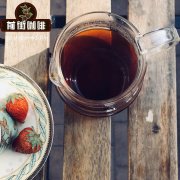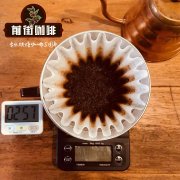Varieties and main producing areas of coffee beans Kenya coffee recommends refreshing sour and sweet fruit flavor

Professional coffee knowledge exchange more coffee bean information please follow the coffee workshop (Wechat official account cafe_style)
Qianjie-introduction to Kenyan Coffee
Although the Kenyan coffee industry started very late, Kenyan coffee is appreciated by coffee fans for its typical and irresistible fruit-like aroma. Kenya is geographically bordered by Ethiopia. Although coffee cultivation started more slowly than Ethiopia, the government's attention and support to the coffee industry has made obvious differences in variety, bean appearance and flavor. Kenyan coffee has a rather refreshing and sweet fruit flavor.
Altitude, latitude, geology: the equator runs through Kenya, and the border is just within ten degrees of north and south latitude. Belonging to tropical producing areas, there are two rainy seasons every year, with two harvests, with 60% concentrated from October to December and another 40% from June to August. Coffee is mainly grown in volcanic areas around the capital Narobi to the mountains of Kenya at an altitude of 1600-2100 meters, most of which are more than 1500 meters. This height is suitable for the development of coffee bean flavor, because the mountain temperature is lower, the growth is slow, the aroma components of coffee beans have been fully developed, the sour taste is more obvious, and the texture is harder. This fertile moonbend-shaped coffee area is the main producer of Kenyan boutique beans. Coffee is Kenya's second export product after tea.
The most important and unique coffee variety in Kenya is SL28/SL34, two coffee varieties with pure Kenyan coffee pedigree, rich berry flavor and elegant red wine flavor, rich chocolate finish, are often won by expert cup tests and auctions.
Although the Kenyan coffee variety SL28/SL34 has a good flavor, it is extremely poor in terms of yield and disease resistance. for this reason, in recent years, Kenya has planted a large area of Ruilu coffee beans with stronger disease resistance, while the pure SL28/SL34 pedigree coffee beans have been shrinking, but this new variety of coffee has not been favored by coffee lovers. Coffee lovers think that Ruiru coffee is sour but not fragrant, but the flavor is very vulgar. With the pure Kenyan AA coffee that amazes coffee lovers, especially the rotten wood flavor of Ruiru coffee when cooled, the Ruiru coffee variety does not produce much, although it currently accounts for only 10% of Kenyan coffee.
In 1930, the newly established Scott Labs, commissioned by the Kenyan government, selected the varieties suitable for the country. 42 primary varieties were numbered and screened one by one, and finally got SL-28 and SL-34. The former comes from bourbon and SL-34 comes from iron pickup, which is not a series of varieties.
At the beginning, the goal of breeding SL28 was to produce a large number of coffee beans with high quality and resistance to diseases and insect pests, but in some producing areas, the goal of breeding was mainly high yield and disease resistance, without considering disease resistance.
Thanks to the bourbon gene, although the later SL28 yield was not as expected, the copper leaf color and broad bean-shaped beans have great sweetness, balance and complex flavor, as well as significant citrus and black plum characteristics. SL34 is similar to SL28 in flavor, with a softer and cleaner finish than SL28, except for its complex acidity and great sweetness. SL34 is of iron pickup blood. The appearance of beans is similar to that of SL28 and is more suitable for rainforest growth.
It turns out that the former is highly rated, usually with blackcurrant-like acidity and complex flavor, while the latter is slightly inferior, but also has an eye-catching fruit flavor. These two varieties, which currently account for 90% of Kenya's output, have become generally recognized representatives of Kenyan coffee varieties. South America is also actively introducing SL28 as a cultivated variety.
Knowledge expansion: 72-hour fermentation water washing treatment is a cyclic repeated treatment method after harvest and fermentation. The best quality coffee cherries were selected on the harvest day, peeled and fermented for 24 hours, and then washed with clean river water 24 hours later.
In short: Qianjie is a coffee research hall, happy to share the knowledge about coffee with you, we share unreservedly just to make more friends fall in love with coffee, and there will be three low-discount coffee activities every month. The reason is that Qianjie wants to make more friends drink the best coffee at the lowest price, which has been Qianjie's tenet for 6 years!
END
Important Notice :
前街咖啡 FrontStreet Coffee has moved to new addredd:
FrontStreet Coffee Address: 315,Donghua East Road,GuangZhou
Tel:020 38364473
- Prev

Where are the four major producing areas of coffee beans in the world? what are the main areas of coffee in Africa?
Professional coffee knowledge exchange more coffee bean information please follow the coffee workshop (Wechat official account cafe_style) Qianjie-world famous producing areas-Yega Xuefei introduction to the four major coffee producing areas in the world 1 South America: more obvious flavor: strong acidity, mellow in the genus. 2 Asia-Pacific region: obvious flavor, mostly low acid, heavy alcohol. 3 Africa and Middle East: more
- Next

Imported coffee bean brand-Superme Kenya Kiambu washing fresh lemon blossom flavor
Professional coffee knowledge exchange more coffee bean information please follow the coffee workshop (Wechat official account cafe_style) front street-imported coffee brand Superme Kenya Kiambu washing introduction Kenya is located in eastern Africa, the equator runs through the middle, East Africa's Great Rift Valley runs through the north and south. The eastern coast is about 500m above sea level, and the western plateau is the eastern part of the Great Rift Valley of East Africa, with an elevation of 2000-3000 m. From
Related
- Beginners will see the "Coffee pull flower" guide!
- What is the difference between ice blog purified milk and ordinary milk coffee?
- Why is the Philippines the largest producer of crops in Liberia?
- For coffee extraction, should the fine powder be retained?
- How does extracted espresso fill pressed powder? How much strength does it take to press the powder?
- How to make jasmine cold extract coffee? Is the jasmine + latte good?
- Will this little toy really make the coffee taste better? How does Lily Drip affect coffee extraction?
- Will the action of slapping the filter cup also affect coffee extraction?
- What's the difference between powder-to-water ratio and powder-to-liquid ratio?
- What is the Ethiopian local species? What does it have to do with Heirloom native species?

